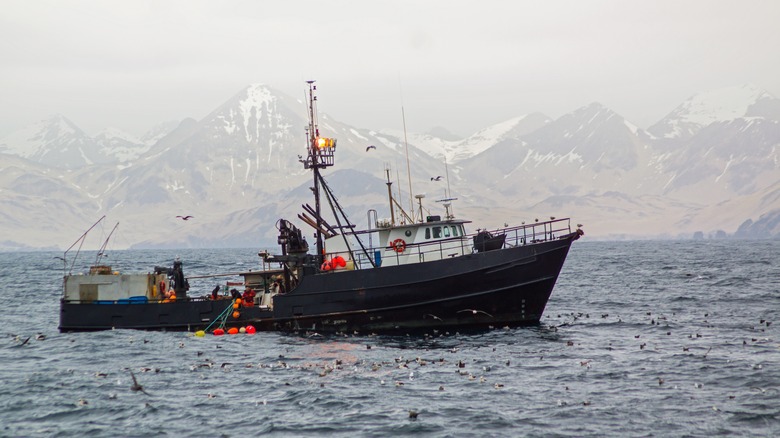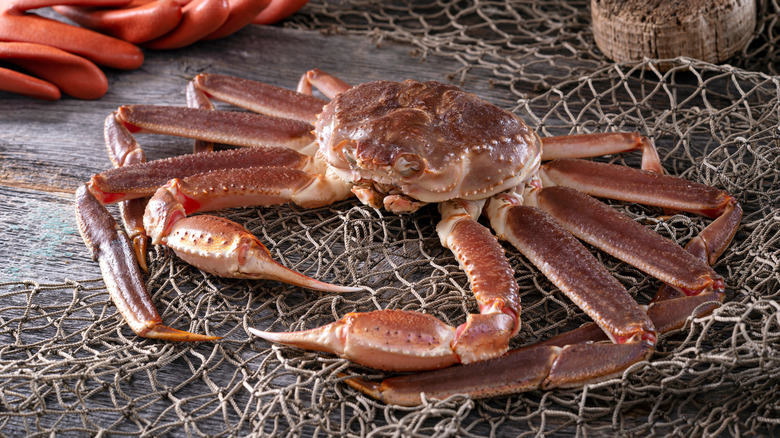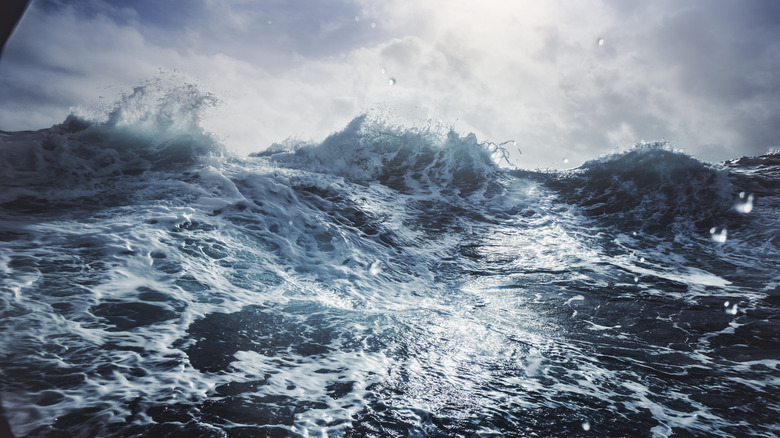All The Ways Climate Change Is Taking A Toll On Deadliest Catch
"Deadliest Catch" has anchored itself as a staple of Discovery Channel programming since 2005, offering viewers a visceral glimpse into the perilous lives of crab fishermen navigating the unforgiving waters of the Bering Sea. Through its documentary-style approach, the show has unflinchingly showcased the extreme dangers and challenges inherent to this profession. The boats on "Deadliest" Catch are actually out at sea for a long time, so the crew must battle relentless weather conditions while confronting the physical and mental strains of long work shifts. These two factors combine to result in some of the most painful injuries ever broadcast on television in recent decades.
As the show's popularity has grown, so too has the awareness of broader environmental shifts. When nature serves as the stage of your show, any changes to the environment inevitably impact production. Outdoor adventure programs such as "The Amazing Race" and "Survivor" are experiencing firsthand the toll that climate change can take on their filming processes, and "Deadliest Catch" is no exception.
Against the icy backdrop of the Bering Sea, climate change has emerged as a significant factor in reshaping the very landscape upon which "Deadliest Catch" unfolds, creating an increasingly palpable shadow over the daring exploits of its crab-fishing crews. Read on to discover all the ways that climate change is taking a toll on "Deadliest Catch."
Climate change is impacting crab populations
Climate change is altering the delicate ecosystems in the Bering Sea, posing significant challenges for the region's snow and king crab populations, which are prominently featured species on "Deadliest Catch." One of the most visible impacts of climate change is the rising water temperatures in seas and oceans. Snow and king crab species rely on cold temperatures to thrive, however, as the Arctic warms up, these creatures' native habitats are becoming increasingly uninhabitable.
Snow and king crabs also face threats in the form of diminishing sea ice cover. These crustaceans rely on sea ice melt which sinks to the ocean floor in the summers creating an icy cold haven where they are protected from predators. However, the unseasonable melting of polar ice caps and glaciers due to climate change is creating a decline in sea ice extent and thickness causing crabs to lose critical refuge spaces, leaving them more vulnerable to predation and other environmental stressors.
As a result, marine scientists and fisheries have observed a significant decline in crab numbers, with populations plummeting to unprecedented lows. The situation became so dire that in 2022, the Alaska Department of Fish and Game prohibited fishermen from catching Bering Sea snow crab altogether. In response to these challenges, the "Deadliest Catch" crew had to adapt, having been forced to explore alternative fishing and filming grounds, including those in Norway, in search of viable crab populations. However, the long-term sustainability of these adaptations remains uncertain, as the underlying drivers of climate change continue to intensify.
Changing global temperatures are creating rougher seas
As climate change causes a shift in global weather patterns, so too does it affect the ocean currents. These changes are affecting the very swells of the seas. Alaskan waters are already notorious for being rough, often cited as one of the most dangerous spots to fish in the world, and as temperatures in the region warm at a rate twice as fast as the global average, fishing operations are expected to face even more significant challenges. Rougher seas and storm conditions can disrupt fish migration patterns and disturb marine habitats, affecting the distribution and abundance of fish stocks. For crab fishermen featured on "Deadliest Catch," these changes can make it more challenging to locate and catch crabs, leading to economic losses and operational risks.
Beyond directly impacting the crab species that fishermen on "Deadliest Catch" make a living off of, these hazards are compounded by the phenomenon of climate change driving ocean acidification. As seawater absorbs excess carbon dioxide from the atmosphere, it undergoes acidification, which can weaken marine ecosystems and coral reefs. Consequently, these ecosystems become less effective at buffering the impact of storms, which can increase the risk of injuries, or even drowning which is one of the most common ways that people die while fishing.
In the context of "Deadliest Catch," the need to adapt and build more resilient fishing practices becomes increasingly urgent for both the safety of the crews and the sustainability of the industry.


